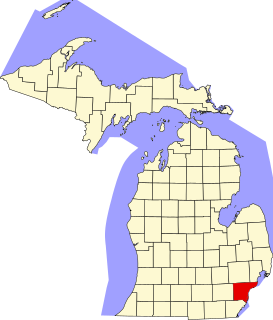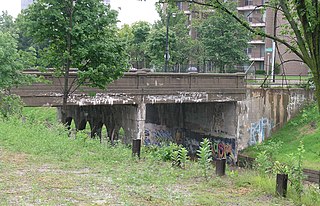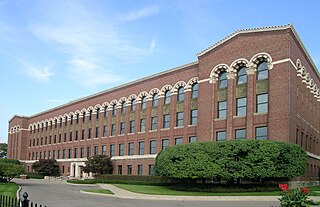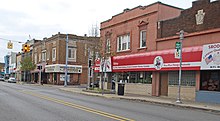
Hamtramck is a city in Wayne County in the U.S. state of Michigan. As of the 2020 census, the city population was 28,433. Hamtramck is surrounded by the city of Detroit except for a small portion of the western border that touches the similarly surrounded city of Highland Park. Hamtramck is by far the most densely-populated municipality in the state of Michigan.

Parke-Davis is a subsidiary of the pharmaceutical company Pfizer. Although Parke, Davis & Co. is no longer an independent corporation, it was once America's oldest and largest drug maker, and played an important role in medical history. In 1970 Parke-Davis was acquired by Warner-Lambert, which in turn was acquired by Pfizer in 2000.

This is a list of the National Register of Historic Places listings in Wayne County, Michigan.

St. Florian Church is a Roman Catholic Church at 2626 Poland Street in Hamtramck, Michigan. The church was designed by Ralph Adams Cram of the firm Cram and Ferguson.

The architecture of metropolitan Detroit continues to attract the attention of architects and preservationists alike. With one of the world's recognizable skylines, Detroit's waterfront panorama shows a variety of architectural styles. The post-modern neogothic spires of One Detroit Center refer to designs of the city's historic Art Deco skyscrapers. Together with the Renaissance Center, they form the city's distinctive skyline.

Tourism in metropolitan Detroit, Michigan is a significant factor for the region's culture and for its economy, comprising nine percent of the area's two million jobs. About 15.9 million people visit Metro Detroit annually, spending an estimated $4.8 billion. Detroit is one of the largest American cities and metropolitan regions to offer casino resort hotels. Leading multi-day events throughout Metro Detroit draw crowds of hundreds of thousands to over three million people. More than fifteen million people cross the highly traveled nexus of the Ambassador Bridge and the Detroit-Windsor Tunnel annually. Detroit is at the center of an emerging Great Lakes Megalopolis. An estimated 46 million people live within a 300-mile (480 km) radius of Metro Detroit.

The Detroit International Riverfront is a tourist attraction and landmark of Detroit, Michigan extending from the Ambassador Bridge in the west to Belle Isle in the east, for a total of 5.5 miles. The International Riverfront encompasses a cruise ship passenger terminal and dock, a marina, a multitude of parks, restaurants, retail shops, skyscrapers, and high rise residential areas along with TCF Center. The Marriott at the Renaissance Center and the Robert's Riverwalk Hotel are also situated along the International Riverfront. Private companies and foundations together with the city, state, and federal government have contributed several hundred million dollars toward the riverfront development. Key public spaces in the International Riverfront, such as the RiverWalk, Dequindre Cut Greenway and Trail, William G. Milliken State Park and Harbor, and a cruise ship passenger terminal and dock at Hart Plaza complement the architecture of the area. The area provides a venue for a variety of annual events and festivals including the Detroit Electronic Music Festival, Detroit Free Press International Marathon, the Detroit International Jazz Festival, Motor City Pride, the North American International Auto Show, River Days and Detroit China Festival. In February 2021, the Detroit International Riverfront was voted best riverwalk in the United States by USA Today readers.

The Roberts Riverwalk Hotel and Residence Detroit, formerly the Parke-Davis Research Laboratory also once known as Building 55-Detroit Research, is located on Joseph Campau Street at the Detroit River, in Detroit, Michigan. The former research facility was redeveloped as a boutique luxury hotel located on the Detroit International Riverfront. The building was designated a National Historic Landmark in 1976 for its historic significance as an early research laboratory.

This is a list of the National Register of Historic Places listings in Detroit, Michigan.

The Antietam Avenue Bridge was located where Antietam Avenue passed over the Dequindre Cut in Detroit, Michigan. It has been demolished due to structural deficiencies and will be reconstructed. The original bridge was listed on the National Register of Historic Places in 2000.

The Chestnut Street Bridge is located where Chestnut Street passes over the Dequindre Cut in Detroit, Michigan. It was listed on the National Register of Historic Places in 2000.

The Joseph Campau House is a private residence located at 2910 East Jefferson Avenue in Detroit, Michigan. It was listed on the National Register of Historic Places in 1985. The house is currently used as a law office.

The historic River Place is located in Detroit, Michigan, bounded by Joseph Campau Avenue, Wight Street, McDougall Street, and the Detroit International Riverfront. It was formerly the Parke-Davis and Company Pharmaceutical Plant. The complex was listed on the National Register of Historic Places in 1985.

The East Jefferson Avenue Residential District in Detroit, Michigan, includes the Thematic Resource (TR) in the multiple property submission to the National Register of Historic Places which was approved on October 9, 1985. The structures are single-family and multiple-unit residential buildings with construction dates spanning nearly a century, from 1835 to 1931. The area is located on the lower east side of the city.

The Dequindre Cut is a below-grade pathway, formerly a Grand Trunk Western Railroad line, located on the east side of Detroit, Michigan, just west of St. Aubin Street. Much of the Cut has been converted to a greenway; the colorful graffiti along the pathway has been left in place.

Detroit is a popular city for cycling. It is flat with an extensive road network with a number of recreational and competitive opportunities and is, according to cycling advocate David Byrne, one of the top eight biking cities in the world. The city has invested in greenways and bike lanes and other bicycle-friendly infrastructure. Bike rental is available from the riverfront and tours of the city's architecture can be booked.

This is a list of the National Register of Historic Places listings in Downtown and Midtown Detroit, Michigan. It is intended to be a complete list of the properties and districts on the National Register of Historic Places in Downtown and Midtown neighborhoods in Detroit, Michigan, United States. Latitude and longitude coordinates are provided for many National Register properties and districts; these locations may be seen together in online maps.

The Joseph Campau Historic District is a commercial historic district located along Joseph Campau Street in Hamtramck, Michigan. The district runs from roughly Holbrook and Lehman Streets on the south to Pulaski and Casmere Streets on the north. It was listed on the National Register of Historic Places in 2012.

Joseph Campau was among Detroit, Michigan's leading citizens and wealthiest landowners at the beginning of the 19th century. Campau had three trading posts and a store in Detroit until the early 1800s. He then embarked on a real estate career that made him very wealthy. Campau was also a newspaper man, establishing a newspaper with his nephew, John R. Williams. He held several city public offices for the city. Campau was an officer in the Michigan Territory Militia and during the War of 1812.






















